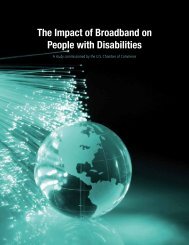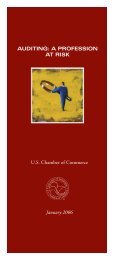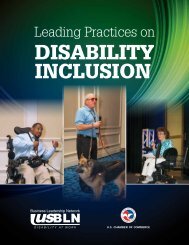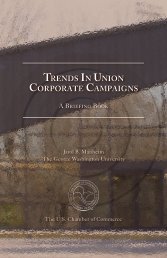[PDF] A Response by the International Organisation of Employers to ...
[PDF] A Response by the International Organisation of Employers to ...
[PDF] A Response by the International Organisation of Employers to ...
- No tags were found...
You also want an ePaper? Increase the reach of your titles
YUMPU automatically turns print PDFs into web optimized ePapers that Google loves.
6A <strong>Response</strong> <strong>by</strong> <strong>the</strong> <strong>International</strong> <strong>Organisation</strong> <strong>of</strong> <strong>Employers</strong>The Principles <strong>of</strong> Freedom <strong>of</strong> Association Under<strong>International</strong> LawThe principles <strong>of</strong> freedom <strong>of</strong> association as <strong>the</strong>y are defined at <strong>the</strong> international levelappear in a variety <strong>of</strong> international instruments. Article 20 <strong>of</strong> <strong>the</strong> United Nations’Universal Declaration <strong>of</strong> Human Rights provides for <strong>the</strong> right <strong>to</strong> freedom <strong>of</strong> association,and <strong>the</strong> corresponding right not <strong>to</strong> associate. 11 Freedom <strong>of</strong> association and <strong>the</strong> right <strong>to</strong>collective bargaining are corners<strong>to</strong>ne principles <strong>of</strong> <strong>the</strong> ILO. 12 Two ILO Conventionsgovern <strong>the</strong> basic principles <strong>of</strong> freedom <strong>of</strong> association and <strong>the</strong> right <strong>to</strong> collectivebargaining as <strong>the</strong>y are defined at <strong>the</strong> international level: Conventions 87 and 98.Convention 87, Freedom <strong>of</strong> Association and Protection <strong>of</strong> <strong>the</strong> Right <strong>to</strong> Organise,was adopted in 1948, 13 and focuses on <strong>the</strong> rights <strong>of</strong> workers <strong>to</strong> form and join labourorganizations freely. 14 Article II <strong>of</strong> Convention 87 provides that “[w]orkers andemployers, without distinction whatsoever, shall have <strong>the</strong> right <strong>to</strong> establish and,subject only <strong>to</strong> <strong>the</strong> rules <strong>of</strong> <strong>the</strong> organization concerned, <strong>to</strong> join organizations <strong>of</strong> <strong>the</strong>irown choosing without previous authorisation.” 15Convention 98, Right <strong>to</strong> Organise and Collective Bargaining Convention, wasadopted in 1949, 16 and relates <strong>to</strong> protections <strong>of</strong> workers who seek representation and<strong>the</strong> right <strong>to</strong> engage in collective bargaining. 17 Article IV <strong>of</strong> Convention 98 providesthat “[m]easures appropriate <strong>to</strong> national conditions shall be taken, where necessary<strong>to</strong> encourage and promote <strong>the</strong> full development and utilization <strong>of</strong> machinery forvoluntary negotiation between employers or employers’ organizations and workers’organizations, with a view <strong>to</strong> <strong>the</strong> regulation <strong>of</strong> terms and conditions <strong>of</strong> employment <strong>by</strong>means <strong>of</strong> collective agreements.” 1811 U.N. UNIVERSAL DECLARATION OF HUMAN RIGHTS Art. XX (1948).12 The ILO Constitution mentions <strong>the</strong> freedom <strong>of</strong> association in its preamble. In relevant part, it states:“And whereas conditions <strong>of</strong> labor exist involving such injustice hardship and privation <strong>to</strong> large numbers<strong>of</strong> people as <strong>to</strong> produce unrest so great that <strong>the</strong> peace and harmony <strong>of</strong> <strong>the</strong> world are imperilled; and animprovement <strong>of</strong> those conditions is urgently required; as, for example, <strong>by</strong> … recognition <strong>of</strong> <strong>the</strong> principle<strong>of</strong> freedom <strong>of</strong> association …” U.N. ILO CONST. pmbl., available at http://www.ilo.org/ilolex/english/iloconst.htm (last visited May 3, 2011). ILO Conventions apply <strong>to</strong> member nations that have ratified <strong>the</strong>m.Article 20 <strong>of</strong> <strong>the</strong> ILO Constitution governs <strong>the</strong> registration <strong>of</strong> Conventions <strong>by</strong> <strong>the</strong> ILO with <strong>the</strong> UnitedNations. The text reads, “[a]ny Convention so ratified shall be communicated <strong>by</strong> <strong>the</strong> Direc<strong>to</strong>r-General<strong>of</strong> <strong>the</strong> <strong>International</strong> Labour Office <strong>to</strong> <strong>the</strong> Secretary-General <strong>of</strong> <strong>the</strong> United Nations for registration inaccordance with <strong>the</strong> provisions <strong>of</strong> article 102 <strong>of</strong> <strong>the</strong> Charter <strong>of</strong> <strong>the</strong> United Nations but shall only be bindingupon <strong>the</strong> Members which ratify it.” ILO CONST. Art. XX. A Convention is an instrument <strong>of</strong> <strong>the</strong> ILOcreated <strong>by</strong> <strong>the</strong> ILO Conference and ratified <strong>by</strong> member states. U.N. ILO CONST. Art. XIX. The principle<strong>of</strong> freedom <strong>of</strong> association is also found in <strong>the</strong> 1998 Declaration on Fundamental Principles and Rights atWork which apply <strong>to</strong> ILO member states as “principles” <strong>to</strong> be realized even if <strong>the</strong>y have not ratified <strong>the</strong>Conventions from which <strong>the</strong> principles are drawn.13 U.N. ILO, Convention No. 87 (1948).14 Id.15 Id., at Art. II.16 U.N. ILO, Convention No. 98 (1949).17 Id.18 Id. at Art. IV.


![[PDF] A Response by the International Organisation of Employers to ...](https://img.yumpu.com/41807569/10/500x640/pdf-a-response-by-the-international-organisation-of-employers-to-.jpg)













